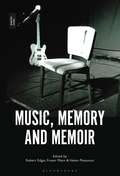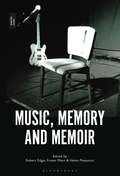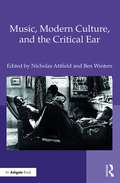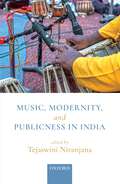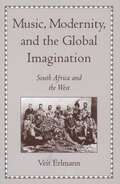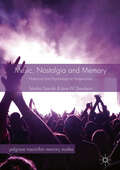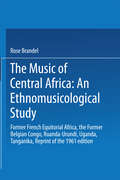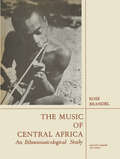- Table View
- List View
Music, Memory and Memoir
by Robert Edgar Fraser Mann Helen PleasanceMusic, Memory and Memoir provides a unique look at the contemporary cultural phenomenon of the music memoir and, leading from this, the way that music is used to construct memory. Via analyses of memoirs that consider punk and pop, indie and dance, this text examines the nature of memory for musicians and the function of music in creating personal and cultural narratives. This book includes innovative and multidisciplinary approaches from a range of contributors consisting of academics, critics and musicians, evaluating this phenomenon from multiple academic and creative practices, and examines the contemporary music memoir in its cultural and literary contexts.
Music, Memory and Memoir
by Robert Edgar Fraser Mann Helen PleasanceMusic, Memory and Memoir provides a unique look at the contemporary cultural phenomenon of the music memoir and, leading from this, the way that music is used to construct memory. Via analyses of memoirs that consider punk and pop, indie and dance, this text examines the nature of memory for musicians and the function of music in creating personal and cultural narratives. This book includes innovative and multidisciplinary approaches from a range of contributors consisting of academics, critics and musicians, evaluating this phenomenon from multiple academic and creative practices, and examines the contemporary music memoir in its cultural and literary contexts.
Music, Mind, and Embodiment: 11th International Symposium, CMMR 2015, Plymouth, UK, June 16-19, 2015, Revised Selected Papers (Lecture Notes in Computer Science #9617)
by Richard Kronland-Martinet Mitsuko Aramaki Sølvi YstadThis book constitutes the thoroughly refereed post-conference of the 11th International Symposium on Computer Music Modeling and Retrieval, CMMR 2015, held in Plymouth, UK, in June 2015. The 30 full papers presented were carefully reviewed and selected from 126 submissions. This year’s post symposium edition contains peer-reviewed and revised articles centered around the conference theme “Music, Mind, and Embodiment”. It is divided into 6 sections devoted to various sound and technology issues with a particular emphasis on performance, music generation, composition, analysis and information retrieval, as well as relations between sound, motion and gestures and human perception and culture.
Music, Modern Culture, and the Critical Ear
by Nicholas Attfield Ben WintersIn his 1985 book The Idea of Music: Schoenberg and Others, Peter Franklin set out a challenge for musicology: namely, how best to talk and write about the music of modern European culture that fell outside of the modernist mainstream typified by Schoenberg, Berg, and Webern? Thirty years on, this collected volume of essays by Franklin’s students and colleagues returns to that challenge and the vibrant intellectual field that has since developed. Moving freely between insights into opera, Volksoper, film, festival, and choral movement, and from the very earliest years of the twentieth century up to the 1980s, its authors listen with a ‘critical ear’: they site these musical phenomena within a wider web of modern cultural practices - a perspective, in turn, that enables them to exercise a disciplinary self-awareness after Franklin’s manner.
Music, Modern Culture, and the Critical Ear
by Nicholas Attfield Ben WintersIn his 1985 book The Idea of Music: Schoenberg and Others, Peter Franklin set out a challenge for musicology: namely, how best to talk and write about the music of modern European culture that fell outside of the modernist mainstream typified by Schoenberg, Berg, and Webern? Thirty years on, this collected volume of essays by Franklin’s students and colleagues returns to that challenge and the vibrant intellectual field that has since developed. Moving freely between insights into opera, Volksoper, film, festival, and choral movement, and from the very earliest years of the twentieth century up to the 1980s, its authors listen with a ‘critical ear’: they site these musical phenomena within a wider web of modern cultural practices - a perspective, in turn, that enables them to exercise a disciplinary self-awareness after Franklin’s manner.
Music, Modernity and Locality in Prewar Japan: Osaka and Beyond (SOAS Studies in Music)
by Alison TokitaThis anthology addresses the modern musical culture of interwar Osaka and its surrounding Hanshin region. Modernity as experienced in this locale, with its particular historical, geographic and demographic character, and its established traditions of music and performance, gave rise to configurations of the new, the traditional and the hybrid that were distinct from their Tokyo counterparts. The Taisho and early Showa periods, from 1912 to the early 1940s, saw profound changes in Japanese musical life. Consumption of both traditional Japanese and Western music was transformed as public concert performances, music journalism, and music marketing permeated daily life. The new bourgeoisie saw Western music, particularly the piano and its repertoire, as the symbol of a desirable and increasingly affordable modernity. Orchestras and opera troupes were established, which in turn created a need for professional conductors, and both jazz and a range of hybrid popular music styles became viable bases for musical livelihood. Recording technology proliferated; by the early 1930s, record players and SP discs were no longer luxury commodities, radio broadcasts reached all levels of society, and ’talkies’ with music soundtracks were avidly consumed. With the perceived need for music that suited 'modern life', the seeds for the pre-eminent position of Euro-American music in post-Second-World war Japan were sown. At the same time many indigenous musical genres continued to thrive, but were hardly immune to the effects of modernization; in exploring new musical media and techniques drawn from Western music, performer-composers initiated profound changes in composition and performance practice within traditional genres. This volume is the first to draw together research on the interwar musical culture of the Osaka region and addresses comprehensively both Western and non-Western musical practices and genres, questions the common perception of their being wholly separate domains
Music, Modernity and Locality in Prewar Japan: Osaka and Beyond (SOAS Studies in Music)
by Alison Tokita Hugh De FerrantiThis anthology addresses the modern musical culture of interwar Osaka and its surrounding Hanshin region. Modernity as experienced in this locale, with its particular historical, geographic and demographic character, and its established traditions of music and performance, gave rise to configurations of the new, the traditional and the hybrid that were distinct from their Tokyo counterparts. The Taisho and early Showa periods, from 1912 to the early 1940s, saw profound changes in Japanese musical life. Consumption of both traditional Japanese and Western music was transformed as public concert performances, music journalism, and music marketing permeated daily life. The new bourgeoisie saw Western music, particularly the piano and its repertoire, as the symbol of a desirable and increasingly affordable modernity. Orchestras and opera troupes were established, which in turn created a need for professional conductors, and both jazz and a range of hybrid popular music styles became viable bases for musical livelihood. Recording technology proliferated; by the early 1930s, record players and SP discs were no longer luxury commodities, radio broadcasts reached all levels of society, and ’talkies’ with music soundtracks were avidly consumed. With the perceived need for music that suited 'modern life', the seeds for the pre-eminent position of Euro-American music in post-Second-World war Japan were sown. At the same time many indigenous musical genres continued to thrive, but were hardly immune to the effects of modernization; in exploring new musical media and techniques drawn from Western music, performer-composers initiated profound changes in composition and performance practice within traditional genres. This volume is the first to draw together research on the interwar musical culture of the Osaka region and addresses comprehensively both Western and non-Western musical practices and genres, questions the common perception of their being wholly separate domains
Music, Modernity, and Publicness in India
by Tejaswini NiranjanaWith the onset of modernity in twentieth-century India, new social arrangements gave rise to new forms of music-making. The musicians were no longer performing exclusively in the princely courts or in the private homes of the wealthy. Not only did the act of listening to and appreciating music change, it became an important feature of public life, thus influencing how modernity shaped itself. This volume attempts to study the connections between music and the creation of new ideas of publicness during the early twentieth century. How was music labelled as folk or classical? How did music come to play such a catalytic role in forming identities of nationhood, politics, or ethnicity? And how did twentieth-century technologies of sound reproduction and commercial marketing contribute to changing notions of cultural distinction? Exploring these interdisciplinary questions across multiple languages, regions, and musical genres, the essays provide fresh perspectives on the history of musicians and migration in colonial India, the formation of modern spaces of performance, and the articulation of national as well as nationalist traditions.
Music, Modernity, and the Global Imagination: South Africa and the West
by Veit ErlmannHow was Africa seen by the West during the colonial period? How do Europeans and Americans conceive of Africa in today's postcolonial era? Such questions have preoccupied anthropologists, historians, and literary scholars for years. But few have asked the reverse: how did--and do--Africans see Europe and the United States? Fewer still have wondered how Western images of Africa and African representations of the West might mirror one another. In a detailed study spanning from the late nineteenth century to the present, renowned anthropologist and ethnomusicologist Veit Erlmann examines the very creation of a global imagination for black South Africans, Europeans, and African Americans. To this end, he explores two striking episodes in the history of black South African music. The first is a pair of tours made by two black South African choirs in England and America in the early 1890s; the second is a series of engagements with the international music industry as experienced by the premier choral group Ladysmith Black Mambazo after the release of Paul Simon's celebrated Graceland album in 1986. Readers will find the cast of characters involved in these intertwined and international dramas at once telling and impressive. Among the many players are African National Congress co-founder Saul Msane, Queen Victoria, African-American musician and impresario Orpheus McAdoo, Xhosa Christian prophet Ntsikana, W. E. B. Du Bois, Michael Jackson, and Spike Lee. Music, Modernity, and the Global Imagination tells the story of how these artists, activists, and agents effectively invented each other in travel diaries, religious hymns, concert performances, music videos, Broadway plays, and autobiographies. Erlmann also argues that the resultant mixture of myths and fictions--as distinctly imagined by these diverse historical actors--entangled South Africa and the West in ways that often obscured the newly emergent global imbalances of power, or else blurred the polarities of the colonial and postcolonial world. Ultimately, this book reports on a transatlantic dialogue that carries direct and profound implications for the world's arts and cultures. It is the black diasporic discussion between South Africa and the West, and it is a conversation--about society, music, and Utopia--that is still in progress.
Music, Music Therapy and Trauma: International Perspectives
by Diane Snow AustinMusic communicates where words fail, and music therapy has been proven to connect with those who were thought to be unreachable, making it an ideal medium for working with those who have suffered psychological trauma. Music, Music Therapy and Trauma addresses the need for an exploration of current thinking on music and trauma.
Music, Musicians, and the Saint-Simonians
by Ralph P. LockeThe Saint-Simonians, whose movement flourished in France between 1825 and 1835, are widely recognized for their contributions to history and social thought. Until now, however, no full account has been made of the central role of the arts in their program. In this skillful interdisciplinary study, Ralph P. Locke describes and documents the Saint-Simonians' view of music as an ideological tool and the influence of this view on musical figures of the day. The disciples of Claude Henri de Rouvroy, comte de Saint-Simon, believed that increased industrial production would play a crucial role in improving the condition of the working masses and in shifting power from the aristocratic "drones" to the enterprising men of talent then rising in the French middle class. As a powerful means of winning support for their views, music became an integral part of the Saint-Simonians' writings and ceremonial activities. Among the musicians Locke discusses are Berlioz, Liszt, and Mendelssohn, whose tangential association with the Saint-Simonians reveals new aspects of their social and aesthetic views. Other musicians became the Saint-Simonians' faithful followers, among them Jules Vinçard, Dominique Tajan-Rogé, and particularly Félicien David, the movement's principal composer. Many of these composers' works, reconstructed by Locke from authentic sources, are printed here, including the "Premier Chant des industriels," written at Saint-Simon's request by Rouget de Lisle, composer of the "Marseillaise."
Music, National Identity and the Politics of Location: Between the Global and the Local (Ashgate Popular and Folk Music Series)
by Vanessa KnightsHow are national identities constructed and articulated through music? Popular music has long been associated with political dissent, and the nation state has consistently demonstrated a determination to seek out and procure for itself a stake in the management of 'its' popular musics. Similarly, popular musics have been used 'from the ground up' as sites for both populist and popular critiques of nationalist sentiment, from the position of both a globalizing and a 'local' vernacular culture. The contributions in this book arrive at a critical moment in the development of the study of national cultures and musicology. The book ranges from considerations of the ideological focus of cultural nationalism through to analyses of musical hybridity and musical articulations of other kinds of identities at odds with national identity. The processes of global homogenization are thereby shown to have brought about a transitional crisis for national cultural identities: the evolution of these identities, particularly with reference to the concept of 'authenticity' in music, is situated within broader debates on power, political economy and constructions of the self. Theorizations of practice are employed after the manner of Bourdieu, Gramsci, Goffman, Gadamer, Habermas, Bhabha, Lacan and Zizek. Each contribution acts as a case study to characterize the strategies through which differing modes of musical discourse engage, critique or obscure discourses on national identity. The studies include discussions of: musical representations of Irishness; the relationship between Afropop and World Music; Norwegian club music; the revival of traditional music in Serbia; resistance to cultural homogeneity in Brazil; contemporary Uyghur song in Northwest China; rap and race in French society; technobanda from the barrios of Los Angeles, and Spanish/Moroccan raï. In this way, the book seeks to characterize the ideological configurations that help to activate and sustain hegemonic, amb
Music, National Identity and the Politics of Location: Between the Global and the Local (Ashgate Popular and Folk Music Series)
by Vanessa KnightsHow are national identities constructed and articulated through music? Popular music has long been associated with political dissent, and the nation state has consistently demonstrated a determination to seek out and procure for itself a stake in the management of 'its' popular musics. Similarly, popular musics have been used 'from the ground up' as sites for both populist and popular critiques of nationalist sentiment, from the position of both a globalizing and a 'local' vernacular culture. The contributions in this book arrive at a critical moment in the development of the study of national cultures and musicology. The book ranges from considerations of the ideological focus of cultural nationalism through to analyses of musical hybridity and musical articulations of other kinds of identities at odds with national identity. The processes of global homogenization are thereby shown to have brought about a transitional crisis for national cultural identities: the evolution of these identities, particularly with reference to the concept of 'authenticity' in music, is situated within broader debates on power, political economy and constructions of the self. Theorizations of practice are employed after the manner of Bourdieu, Gramsci, Goffman, Gadamer, Habermas, Bhabha, Lacan and Zizek. Each contribution acts as a case study to characterize the strategies through which differing modes of musical discourse engage, critique or obscure discourses on national identity. The studies include discussions of: musical representations of Irishness; the relationship between Afropop and World Music; Norwegian club music; the revival of traditional music in Serbia; resistance to cultural homogeneity in Brazil; contemporary Uyghur song in Northwest China; rap and race in French society; technobanda from the barrios of Los Angeles, and Spanish/Moroccan raï. In this way, the book seeks to characterize the ideological configurations that help to activate and sustain hegemonic, amb
The Music Never Stops: What Putting on 10,000 Shows Has Taught Me About Life, Liberty, and the Pursuit of Magic
by Peter ShapiroThe engrossing, insightful, and personal musical odyssey of Peter Shapiro, perhaps the most notable independent concert promoter since Bill Graham Peter Shapiro is the best known and most influential concert promoter of his generation. He owned the legendary Wetlands in Tribeca and has gone on to much bigger things, including Brooklyn Bowl (NYC, Las Vegas, Philadelphia, and Nashville), the Capitol Theatre in Port Chester, producing U2 3D, and promoting the Grateful Dead&’s fiftieth-anniversary tour (&“Fare Thee Well&”) featuring the Core Four and Trey Anastasio . . . and so much more. In The Music Never Stops, Shapiro shares the inside story of how he became a power-house in the music industry—an island in an increasingly consolidated landscape of venues, ticketing, and touring—through the lens of fifty iconic concerts. Along the way, readers gain insight into what it was like to work with some of the most celebrated bands in modern music, including not just the Grateful Dead and U2, but also Bob Dylan, Phish, Dave Matthews Band, Al Green, Ms. Lauryn Hill, Jason Isbell, Preservation Hall Jazz Band, The Roots, Robert Plant, Leonard Cohen, and many more. Featuring never-before-published back-stage anecdotes, insights, and photographs of the biggest bands in the business and the concerts that later became legendary, The Music Never Stops is a perfect guide for any-one who wants to understand the modern live music industry.
The Music Never Stops: What Putting on 10,000 Shows Has Taught Me About Life, Liberty, and the Pursuit of Magic
by Peter ShapiroThe engrossing, insightful, and personal musical odyssey of Peter Shapiro, perhaps the most notable independent concert promoter since Bill Graham Peter Shapiro is the best known and most influential concert promoter of his generation. He owned the legendary Wetlands in Tribeca and has gone on to much bigger things, including Brooklyn Bowl (NYC, Las Vegas, Philadelphia, and Nashville), the Capitol Theatre in Port Chester, producing U2 3D, and promoting the Grateful Dead&’s fiftieth-anniversary tour (&“Fare Thee Well&”) featuring the Core Four and Trey Anastasio . . . and so much more. In The Music Never Stops, Shapiro shares the inside story of how he became a power-house in the music industry—an island in an increasingly consolidated landscape of venues, ticketing, and touring—through the lens of fifty iconic concerts. Along the way, readers gain insight into what it was like to work with some of the most celebrated bands in modern music, including not just the Grateful Dead and U2, but also Bob Dylan, Phish, Dave Matthews Band, Al Green, Ms. Lauryn Hill, Jason Isbell, Preservation Hall Jazz Band, The Roots, Robert Plant, Leonard Cohen, and many more. Featuring never-before-published back-stage anecdotes, insights, and photographs of the biggest bands in the business and the concerts that later became legendary, The Music Never Stops is a perfect guide for any-one who wants to understand the modern live music industry.
Music, Nostalgia and Memory: Historical and Psychological Perspectives (Palgrave Macmillan Memory Studies)
by Sandra Garrido Jane W. DavidsonHow are our personal soundtracks of life devised? What makes some pieces of music more meaningful to us than others? This book explores the role of memory, both personal and cultural, in imbuing music with the power to move us. Focusing on the relationship between music and key life moments from birth to death, the text takes a cross-disciplinary approach, combining perspectives from a ‘history of emotions’ with modern day psychology, empirical surveys of modern-day listeners and analysis of musical works. The book traces the trajectory of emotional response to music over the past 500 years, illuminating the interaction between personal, historical and contextual variables that influence our hard-wired emotional responses to music, and the key role of memory and nostalgia in the mechanisms of emotional response.
Music of Anthony Braxton
by HeffleyFirst Published in 2001. Routledge is an imprint of Taylor & Francis, an informa company.
Music of Anthony Braxton (Contributions To The Study Of Music And Dance Ser. #No. 43)
by HeffleyFirst Published in 2001. Routledge is an imprint of Taylor & Francis, an informa company.
The Music of Central Africa: Former French Equatorial Africa the Former Belgian Congo, Ruanda-Urundi Uganda, Tanganyika
by R. BrandelUnder the inspiring guidance of my mentor, Curt Sachs, this work was conceived, planned, and executed. It gained in dimension under the acute and patient perusal of Gustave Reese to whose brilliant propensity for clarity of thought and of style lowe a huge debt. Furthermore, the helpful suggestions made by Martin Bernstein and by Jan LaRue are gratefully acknowledged. If Jaap Kunst had not kindly gone to the trouble of ordering, supervising the con struction of, and mailing to me from Amsterdam his personally designed monochord, an important section of this work could not have taken form. This preface is not complete, of course, without final thanks to my husband, Harvey B. N atanson, for his sustained interest and encouragement. R. B. Note As the present work goes to press, the political map of Africa is flowing into a new mold. Several countries have obtained independence, and new names and data should be con sidered: French Equatorial Africa has become (November 28-December I, 1958) four independent countries - Republic of the Congo: Brazzaville (formerly Middle Congo), Gabon Republic (formerly Gabon), Central African Republic (formerly Ubangi-Shari), and Republic of Chad (formerly Chad). The Belgian Congo has become (June 30, 1960) the Republic of the Congo: Leopoldville.
The Music of Central Africa: An Ethnomusicological Study Former French Equatorial Africa the Former Belgian Congo, Ruanda-Urundi Uganda, Tanganyika
by Rose BrandelUnder the inspiring guidance of my mentor, Curt Sachs, this work was conceived, planned, and executed. It gained in dimension under the acute and patient perusal of Gustave Reese to whose brilliant propensity for clarity of thought and of style I owe a huge debt. Furthermore, the helpful suggestions made by Martin Bernstein and by J an LaRue are gratefully acknowledged. If Jaap Kunst had not kindly gone to the trouble of ordering, supervising the con struction of, and mailing to me from Amsterdam his personally designed monochord, an important section of this work could not have taken form. This preface is not complete, of course, without final thanks to my husband, Harvey B. Natanson, for his sustained interest and encouragement. R. B. Note As the present work goes to press, the political map of Africa is flowing into a new mold. Several countries have obtained independence, and new names and data should be con sidered: French Equatorial Africa has become (November 28-December I, 1958) four independent countries - Republic of the Congo: Brazzaville (formerly Middle Congo), Gabon Republic (formerly Gabon) , Central African Republic (formerly Ubangi-Shari), and Republic of Chad (formerly Chad). The Belgian Congo has become (June 30,1960) the Republic of the Congo: Leopoldville.
The Music of Chou Wen-chung
by EricC. LaiChou Wen-chung is one of the most influential musical figures of our time. His rich cultural background, his studies with Edgard Var and his interest in the genuine rapport between Eastern and Western musical traditions have been the major influences on his career. Although he is active in various artistic and cultural circles that include scholarship, education and cultural preservation, his major calling has always been composition. As a composer, Chou has created a group of works whose stylistic innovation and technical profundity are distinctive among composers of his generation. His music, which has received critical acclaim around the globe, documents his creative journey, especially in the realization of re-merger - the fusion of Eastern and Western music that has become a new mainstream in art music. Through extensive focus on sketch study, Eric Lai examines Chou's music to contribute to an understanding of his aesthetic orientation, his compositional technique, his role in the development of new music, and his influence upon the younger generation of composers.
The Music of Chou Wen-chung
by EricC. LaiChou Wen-chung is one of the most influential musical figures of our time. His rich cultural background, his studies with Edgard Var and his interest in the genuine rapport between Eastern and Western musical traditions have been the major influences on his career. Although he is active in various artistic and cultural circles that include scholarship, education and cultural preservation, his major calling has always been composition. As a composer, Chou has created a group of works whose stylistic innovation and technical profundity are distinctive among composers of his generation. His music, which has received critical acclaim around the globe, documents his creative journey, especially in the realization of re-merger - the fusion of Eastern and Western music that has become a new mainstream in art music. Through extensive focus on sketch study, Eric Lai examines Chou's music to contribute to an understanding of his aesthetic orientation, his compositional technique, his role in the development of new music, and his influence upon the younger generation of composers.
The Music of Dada: A lesson in intermediality for our times
by Peter Dayan100 years after the Dada soirées rocked the art world, the author investigates the role that music played in the movement. Dada is generally thought of as noisy and unmusical, but The Music of Dada shows that music was at the core of Dada theory and practice. Music (by Schoenberg, Satie and many others) performed on the piano played a central role in the soirées, from the beginnings in Zurich, in 1916, to the end in Paris and Holland, seven years later. The Music of Dada provides a historical analysis of music at Dada events, and asks why accounts of Dada have so consistently ignored music’s vital presence. The answer to that question turns out to explain how music has related to the other arts ever since the days of Dada. The music of Dada is the key to understanding intermediality in our time.
The Music of Dada: A lesson in intermediality for our times
by Peter Dayan100 years after the Dada soirées rocked the art world, the author investigates the role that music played in the movement. Dada is generally thought of as noisy and unmusical, but The Music of Dada shows that music was at the core of Dada theory and practice. Music (by Schoenberg, Satie and many others) performed on the piano played a central role in the soirées, from the beginnings in Zurich, in 1916, to the end in Paris and Holland, seven years later. The Music of Dada provides a historical analysis of music at Dada events, and asks why accounts of Dada have so consistently ignored music’s vital presence. The answer to that question turns out to explain how music has related to the other arts ever since the days of Dada. The music of Dada is the key to understanding intermediality in our time.
The Music of David Lumsdaine: Kelly Ground to Cambewarra
by Michael HooperAustralian by birth but a longtime resident of Great Britain, David Lumsdaine (b.1931) is central to both Australian and British modernism. During the early 1970s Australian musical modernism was at its height. Lumsdaine and his Australian contemporaries were engaged with practices from multiple places, producing music that displays the attributes of their disparate influences; in so doing they formed a new conception of what it meant to be an Australian composer. The period is similarly important in Britain, for it saw the rise to prominence of composers such as Birtwistle, Davies, Goehr, Gilbert, Wood, Cardew and many others who were Lumsdaine's contemporaries, colleagues and friends. Hooper presents here a series of analyses of Lumsdaine's compositions, focusing on works written between 1966 and 1980. At the early end of this period is Kelly Ground, for solo piano. One of Lumsdaine's first acknowledged works, Kelly Ground connects explicitly with the music of high modernism, employing ideas about temporality as espoused by Ligeti, Stockhausen and Boulez, to form a new ritual for the (now mythical) Australian outlaw Ned Kelly. Hooper places Lumsdaine's music in the context of Australian and British avant-gardes, and reveals its elegance, lyricism and technical virtuosity.
